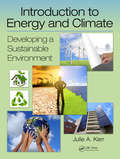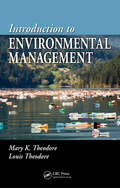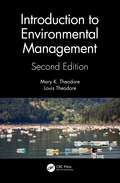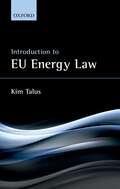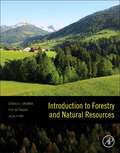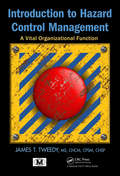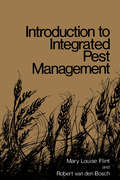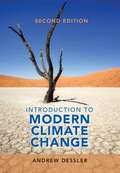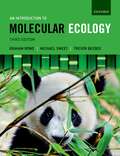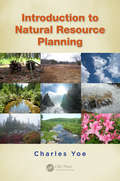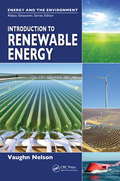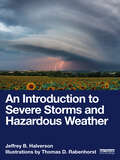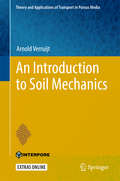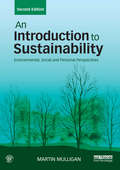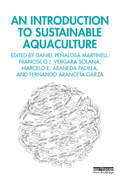- Table View
- List View
Introduction to Energy and Climate: Developing a Sustainable Environment
by Julie KerrThe purpose of this textbook is to provide a well-rounded working knowledge of both climate change and environmental sustainability for a wide range of students. Students will learn core concepts and methods to analyze energy and environmental impacts; will understand what is changing the earth’s climate, and what that means for life on earth now and in the future. They will also have a firm understanding of what energy is and how it can be used. This text intends to develop working knowledge of these topics, with both technical and social implications. Students will find in one volume the integration and careful treatment of climate, energy, and sustainability.
Introduction to Energy and Climate: Developing a Sustainable Environment
by Julie KerrThe purpose of this textbook is to provide a well-rounded working knowledge of both climate change and environmental sustainability for a wide range of students. Students will learn core concepts and methods to analyze energy and environmental impacts; will understand what is changing the earth’s climate, and what that means for life on earth now and in the future. They will also have a firm understanding of what energy is and how it can be used. This text intends to develop working knowledge of these topics, with both technical and social implications. Students will find in one volume the integration and careful treatment of climate, energy, and sustainability.
Introduction to Environment, Biodiversity and Climate Change
by Navale PandharinathEnvironment includes air, water, land and the inter relationship between air water, land and human beings and other living creatures, plants micro-organisms and property. Environment effects the wellbeing of man, animal and plants world over. Man is more advanced in intellect and hence it is the duty of man to protect the environment from undesired pollutions. The book discusses various aspects of Global warming, climate change, health hazards, dwindling of forest, water resources and natural resources and stress on biological diversity.Note: T&F does not sell or distribute the Hardback in India, Pakistan, Nepal, Bhutan, Bangladesh and Sri Lanka.
Introduction to Environment, Biodiversity and Climate Change
by Navale PandharinathEnvironment includes air, water, land and the inter relationship between air water, land and human beings and other living creatures, plants micro-organisms and property. Environment effects the wellbeing of man, animal and plants world over. Man is more advanced in intellect and hence it is the duty of man to protect the environment from undesired pollutions. The book discusses various aspects of Global warming, climate change, health hazards, dwindling of forest, water resources and natural resources and stress on biological diversity.Note: T&F does not sell or distribute the Hardback in India, Pakistan, Nepal, Bhutan, Bangladesh and Sri Lanka.
An Introduction to Environmental Biophysics
by Gaylon S. Campbell John NormanFrom reviews of the first edition:"well organized . . . Recommended as an introductory text for undergraduates" -- AAAS Science Books and Films "well written and illustrated" -- Bulletin of the American Meteorological Society
An Introduction to Environmental Biotechnology
by Milton WainwrightAn Introduction to Environmental Biotechnology provides an introduction to the subject of environmental biotechnology. Environmental biotechnology refers to the use of micro-organisms and other living systems to solve current environmental problems such as the detoxification of pollutants and clean-up of oil tanker spills. Additionally, it refers to the biotechnology of the agricultural environment, as well as the use of biopesticides and the application of microorganisms to the mining, metal recovery and paper industries. This is the only comprehensive introductory account of this subject matter. Beginning with an introduction to microbial growth, An Introduction to Environmental Biotechnology aims to provide the non-specialist with a complete overview of environmental biotechnology. It is presented in an easy to read style with illustrations and includes frequent references to the use of higher plants as well as micro-organisms in environmental biotechnology. An Introduction to Environmental Biotechnology is geared toward a non-specialist audience, including engineers and environmental chemists, and environmental scientists who have limited knowledge of microbiology and biotechnology.
Introduction to Environmental Management
by Mary K. Theodore Louis TheodoreIt is hard to imagine an area of study or a discipline in which a basic knowledge of the issues would not be beneficial, since environmental concerns are very much in the public consciousness. Written at a level that is accessible to students in all disciplines, Introduction to Environmental Management translates complex environmental issues i
Introduction to Environmental Management
by Mary K. Theodore Louis TheodoreWritten at a level that is accessible to students in all disciplines, Introduction to Environmental Management, Second Edition translates complex environmental issues into practical and understandable terms. The book provides students and practitioners an understanding of the regulations, pollutants, and waste management issues that can be applied in various related environmental fields and industries. This new edition is updated throughout and adds eleven new chapters, including coverage of water conservation, water toxins, measurement methods, desalination, industrial ecology, legal issues, and more. Features: Updated throughout and includes eleven all-new chapters Reviews the specialized literature on pollution prevention, sustainability, and the role of optimization in water treatment and related areas, as well as references for further reading Provides illustrative examples and case studies that complement the text throughout Includes ancillary exams and a solutions manual for adopting instructors This book serves as a complete teaching tool, offering a combination of insightful coverage, concise language, and convenient pedagogical features, and supplies practical guidance that will aid students and practitioners alike.
Introduction to Environmental Management
by Mary K. Theodore Louis TheodoreWritten at a level that is accessible to students in all disciplines, Introduction to Environmental Management, Second Edition translates complex environmental issues into practical and understandable terms. The book provides students and practitioners an understanding of the regulations, pollutants, and waste management issues that can be applied in various related environmental fields and industries. This new edition is updated throughout and adds eleven new chapters, including coverage of water conservation, water toxins, measurement methods, desalination, industrial ecology, legal issues, and more. Features: Updated throughout and includes eleven all-new chapters Reviews the specialized literature on pollution prevention, sustainability, and the role of optimization in water treatment and related areas, as well as references for further reading Provides illustrative examples and case studies that complement the text throughout Includes ancillary exams and a solutions manual for adopting instructors This book serves as a complete teaching tool, offering a combination of insightful coverage, concise language, and convenient pedagogical features, and supplies practical guidance that will aid students and practitioners alike.
Introduction to EU Energy Law
by Kim TalusOffering an introduction to students on the most essential elements of EU energy law and policy, this volume will be the go-to text for those seeking knowledge of EU energy regulation and its objectives, as well as an overview of energy law. Specific topics will cover the content of sector-specific energy regulation, the application and impact of general EU law on energy markets, third party access, unbundling, investment in cross-border networks, energy trading and market supervision, the application of general EU competition law on energy markets, the impact of free movement provisions, and the application of state aid rules. A structured, step by step guide through the fundamental areas of EU energy law.
Introduction to EU Energy Law
by Kim TalusOffering an introduction to students on the most essential elements of EU energy law and policy, this volume will be the go-to text for those seeking knowledge of EU energy regulation and its objectives, as well as an overview of energy law. Specific topics will cover the content of sector-specific energy regulation, the application and impact of general EU law on energy markets, third party access, unbundling, investment in cross-border networks, energy trading and market supervision, the application of general EU competition law on energy markets, the impact of free movement provisions, and the application of state aid rules. A structured, step by step guide through the fundamental areas of EU energy law.
Introduction To Forestry And Natural Resources (PDF)
by Donald Grebner Pete Bettinger Jacek SiryIntroduction to Forestry and Natural Resources presents a broad overview of the profession of forestry. The book details several key fields within forestry, including forest health, economics, policy, utilization, and forestry careers. Chapters deal specifically with forest products and harvesting, recreation, wildlife habitats, tree anatomy and physiology, and ethics. These topics are ideal for undergraduate introductory courses and include numerous examples (mainly graphical) and questions for students to ponder. Unlike other introductory forestry texts, which focus largely on forest ecology rather than practical forestry concepts, Introduction to Forestry and Natural Resources encompasses economic, ecological, and social aspects providing a uniquely balanced text. The wide range of experience of the contributing authors equips them especially well to identify missing content from other texts in the area and address topics currently covered in corresponding college courses.
Introduction to Hazard Control Management: A Vital Organizational Function
by James T. TweedyThe International Board for the Certification of Safety Managers (IBFCSM) has designated this text as the Primary Study Reference for those preparing to sit for the Certified Hazard Control Manager (CHCM) and the Certified Hazard Control Manager-Security (CHCM-SEC) Examinations. Introduction to Hazard Control Management: A Vital Organizational Func
Introduction to Integrated Pest Management
by M.L. Flint R. van den BoschIntegrated control of pests was practiced early in this century, well before anyone thought to call it "integrated control" or, still later, "integrated pest management" (IPM), which is the subject of this book by Mary Louise Flint and the late Robert van den Bosch. USDA entomologists W. D. Hunter and B. R. Coad recommended the same principles in 1923, for example, for the control of boll weevil on cotton in the United States. In that program, selected pest-tolerant varieties of cotton and residue destruction were the primary means of control, with insecticides consid ered supplementary and to be used only when a measured incidence of weevil damage occurred. Likewise, plant pathologists had also developed disease management programs incorporating varietal selection and cul tural procedures, along with minimal use of the early fungicides, such as Bordeaux mixture. These and other methods were practiced well before modern chemical control technology had developed. Use of chemical pesticides expanded greatly in this century, at first slowly and then, following the launching of DDT as a broadly successful insecticide, with rapidly increasing momentum. In 1979, the President's Council on Environmental Quality reported that production of synthetic organic pesticides had increased from less than half a million pounds in 1951 to about 1.4 billion pounds-or about 3000 times as much-in 1977.
Introduction To Modern Climate Change (PDF)
by Andrew DesslerThis is an invaluable textbook for any introductory survey course on the science and policy of climate change, for both non-science majors and introductory science students. The second edition has been thoroughly updated to reflect the most recent science from the latest Intergovernmental Panel on Climate Change reports, and many illustrations include new data. The new edition also reflects advances in the political debate over climate change. Unique amongst textbooks on climate change, it combines an introduction to the science with an introduction to economic and policy issues, and is tightly focused on anthropogenic climate change. It contains the necessary quantitative depth for students to properly understand the science of climate change. It supports students in using algebra to understand simple equations and to solve end-of-chapter problems. Supplementary online resources include a complete set of PowerPoint figures for instructors, solutions to exercises, videos of the author's lectures, and additional computer exercises.
Introduction to Modern Climate Change (Second Edition) (PDF)
by Andrew DesslerThis is an invaluable textbook for any introductory survey course on the science and policy of climate change, for both non-science majors and introductory science students. The second edition has been thoroughly updated to reflect the most recent science from the latest Intergovernmental Panel on Climate Change reports, and many illustrations include new data. The new edition also reflects advances in the political debate over climate change. Unique amongst textbooks on climate change, it combines an introduction to the science with an introduction to economic and policy issues, and is tightly focused on anthropogenic climate change. It contains the necessary quantitative depth for students to properly understand the science of climate change. It supports students in using algebra to understand simple equations and to solve end-of-chapter problems. Supplementary online resources include a complete set of PowerPoint figures for instructors, solutions to exercises, videos of the author's lectures, and additional computer exercises.
An Introduction to Molecular Ecology
by Graham Rowe Michael Sweet Trevor BeebeeAn Introduction to Molecular Ecology combines theoretical concepts with practice-driven examples to showcase the latest molecular and genomic techniques and their impact on the study of ecology. The opening chapters introduce the essential molecular and genetic concepts that underpin the subject and describe key molecular tools and methods available to the ecologist. Capturing the broad scope of the field, the book goes on to explore the use of molecular tools in the context of behavioural ecology, population genetics, phylogeography, conservation, and microbial ecology. The third edition includes coverage of exciting new technological and analytical developments, such as next generation sequencing, which have revolutionized the field over the last decade. Molecular ecology is now in a position to tackle some truly ecological questions for the first time since its inception. Blending conceptual detail with the most instructive examples, An Introduction to Molecular Ecology is an ideal resource for those new to the subject needing to develop a strong working understanding of the field. Online Resource Centre The Online Resource Centre to accompany An Introduction to Molecular Ecology features: For students: - Suggested review articles to take your learning further - Links to useful websites and software - A range of questions to consolidate your learning and understanding For registered adopters of the book: - Journal Club; suggested research papers and discussion questions linked to topics featured in the book - Figures from the textbook to view and download
Introduction to Natural Resource Planning
by Charles YoeThis is an exciting time for natural resources planning. There are amazing technologies available to planners and a wide and growing array of resources, problems, and opportunities that need attention. Private and public interests are taking up these issues all over the world and at all levels of involvement. At the same time, inefficient planning
Introduction to Renewable Energy
by Vaughn C. NelsonAs the world population grows and places more demand on limited fossil fuels, renewable energy becomes more relevant as part of the solution to the impending energy dilemma. Renewable energy is now included in national policies, with goals for it to be a significant percentage of generated energy within the coming decades. A comprehensive overview,
An Introduction to Severe Storms and Hazardous Weather
by Jeffrey B. HalversonThis book presents a deep and encompassing survey of severe weather in all its forms. An Introduction to Severe Storms and Hazardous Weather is an exciting new textbook that allows students to learn the principles of atmospheric science through the drama, exhilaration, and even tragedy of severe weather.Balancing breadth and depth, Jeffrey B. Halverson adeptly combines a short, accessible introduction to the basic principles of meteorology with detailed coverage on large- and small-scale weather hazards. He draws on specific up-to-date case studies from North America to illustrate the cause of meteorological events including hurricanes, heavy snow and ice, floods, and tornadoes. Unlike existing books on the market, Halverson delves deep into the societal impacts of these events, drawing on examples from agriculture, utility infrastructure, and commercial aviation. Each chapter also features high-quality, customized color artwork by Thomas D. Rabenhorst that helps to enhance and embed learning.Thorough in its scope, and written with an impeccable focus on the science, this book will be an essential resource for introductory undergraduate courses in severe weather, natural hazards, and extreme meteorology. It is also an excellent supplemental textbook for courses on meteorology and atmospheric science.
An Introduction to Severe Storms and Hazardous Weather
by Jeffrey B. HalversonThis book presents a deep and encompassing survey of severe weather in all its forms. An Introduction to Severe Storms and Hazardous Weather is an exciting new textbook that allows students to learn the principles of atmospheric science through the drama, exhilaration, and even tragedy of severe weather.Balancing breadth and depth, Jeffrey B. Halverson adeptly combines a short, accessible introduction to the basic principles of meteorology with detailed coverage on large- and small-scale weather hazards. He draws on specific up-to-date case studies from North America to illustrate the cause of meteorological events including hurricanes, heavy snow and ice, floods, and tornadoes. Unlike existing books on the market, Halverson delves deep into the societal impacts of these events, drawing on examples from agriculture, utility infrastructure, and commercial aviation. Each chapter also features high-quality, customized color artwork by Thomas D. Rabenhorst that helps to enhance and embed learning.Thorough in its scope, and written with an impeccable focus on the science, this book will be an essential resource for introductory undergraduate courses in severe weather, natural hazards, and extreme meteorology. It is also an excellent supplemental textbook for courses on meteorology and atmospheric science.
An Introduction to Soil Mechanics (Theory and Applications of Transport in Porous Media #30)
by Arnold VerruijtThis textbook offers a superb introduction to theoretical and practical soil mechanics. Special attention is given to the risks of failure in civil engineering, and themes covered include stresses in soils, groundwater flow, consolidation, testing of soils, and stability of slopes. Readers will learn the major principles and methods of soil mechanics, and the most important methods of determining soil parameters both in the laboratory and in situ. The basic principles of applied mechanics, that are frequently used, are offered in the appendices. The author’s considerable experience of teaching soil mechanics is evident in the many features of the book: it is packed with supportive color illustrations, helpful examples and references. Exercises with answers enable students to self-test their understanding and encourage them to explore further through additional online material. Numerous simple computer programs are provided online as Electronic Supplementary Material. As a soil mechanics textbook, this volume is ideally suited to supporting undergraduate civil engineering students.“I am really delighted that your book is now published. When I “discovered” your course a few years ago, I was elated to have finally found a book that immediately resonated with me. Your approach to teaching soil mechanics is precise, rigorous, clear, concise, or in other words “crisp." My colleagues who share the teaching of Soil Mechanics 1 and 2 (each course is taught every semester) at the UMN have also adopted your book.”Emmanuel DetournayProfessor at Dept. of Civil, Environmental, and Geo-Engineering, University of Minnesota, USA
An Introduction to Sustainability: Environmental, Social and Personal Perspectives
by Martin MulliganAn Introduction to Sustainability provides students with a comprehensive overview of the key concepts and ideas which are encompassed within the growing field of sustainability. The fully updated second edition, including new figures and images, teases out the diverse but intersecting domains of sustainability and emphasises strategies for action. Aimed at those studying the subject for the first time, it is unique in giving students from different disciplinary backgrounds a coherent framework and set of core principles for applying broad sustainability principles within their own personal and professional lives. These include: working to improve equality within and across generations; moving from consumerism to quality of life goals; and respecting diversity in both nature and culture. Areas of emerging importance such as the economics of prosperity and wellbeing stand alongside core topics including: · Energy and society · Consumption and consumerism · Risk and resilience · Waste, water and land. Key challenges and applications are explored through international case studies, and each chapter includes a thematic essay drawing on diverse literature to provide an integrated introduction to fundamental issues. Housed on the Routledge Sustainability Hub, the book’s companion website contains a range of features to engage students with the interdisciplinary nature of sustainability. Together these resources provide a wealth of material for learning, teaching and researching the topic of sustainability. This textbook is an essential companion to any sustainability course.
An Introduction to Sustainability: Environmental, Social and Personal Perspectives
by Martin MulliganAn Introduction to Sustainability provides students with a comprehensive overview of the key concepts and ideas which are encompassed within the growing field of sustainability. The fully updated second edition, including new figures and images, teases out the diverse but intersecting domains of sustainability and emphasises strategies for action. Aimed at those studying the subject for the first time, it is unique in giving students from different disciplinary backgrounds a coherent framework and set of core principles for applying broad sustainability principles within their own personal and professional lives. These include: working to improve equality within and across generations; moving from consumerism to quality of life goals; and respecting diversity in both nature and culture. Areas of emerging importance such as the economics of prosperity and wellbeing stand alongside core topics including: · Energy and society · Consumption and consumerism · Risk and resilience · Waste, water and land. Key challenges and applications are explored through international case studies, and each chapter includes a thematic essay drawing on diverse literature to provide an integrated introduction to fundamental issues. Housed on the Routledge Sustainability Hub, the book’s companion website contains a range of features to engage students with the interdisciplinary nature of sustainability. Together these resources provide a wealth of material for learning, teaching and researching the topic of sustainability. This textbook is an essential companion to any sustainability course.
An Introduction to Sustainable Aquaculture
by Daniel Peñalosa Martinell Vergara-Solana, Francisco J Araneda Padilla, Marcelo E Fernando Aranceta GarzaThis new textbook provides an accessible introduction to sustainable aquaculture through its relationship with three key pillars: the environment, the economy, and society.As the demand for seafood keeps increasing, aquaculture is considered one of the most promising and sustainable ways to satisfy this demand with nutritious and high-quality food. It is important to understand, therefore, the wider role and impact aquaculture has on the environment, the economy, and society. The book begins by providing a foundational introduction to aquaculture and sustainability, discussing the complex and interdependent relationship that exists between the two. The core text of the book is divided into four parts which focus on the environment, economics, social impacts, and governance and technologies. Chapters examine key issues surrounding climate change, food security, new technologies, bioeconomics and risk analysis, international cooperation, employment, and animal welfare, with the book concluding with a chapter examining the future directions and challenges for the aquaculture industry. The book draws on global case studies and each chapter is accompanied by recommended reading and chapter review questions to support student learning.This book will serve as an essential guide for students of aquaculture, fisheries management, and sustainable food, as well as practitioners and policymakers engaged in sustainable fishery development.
